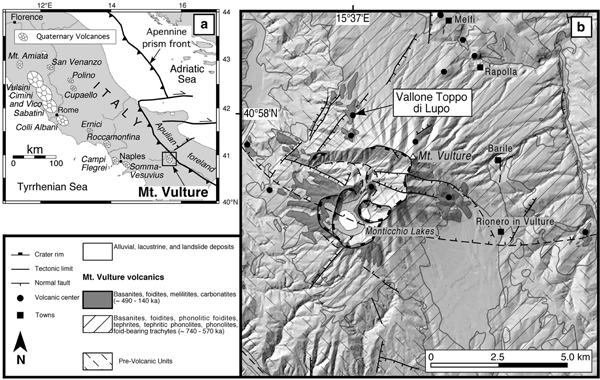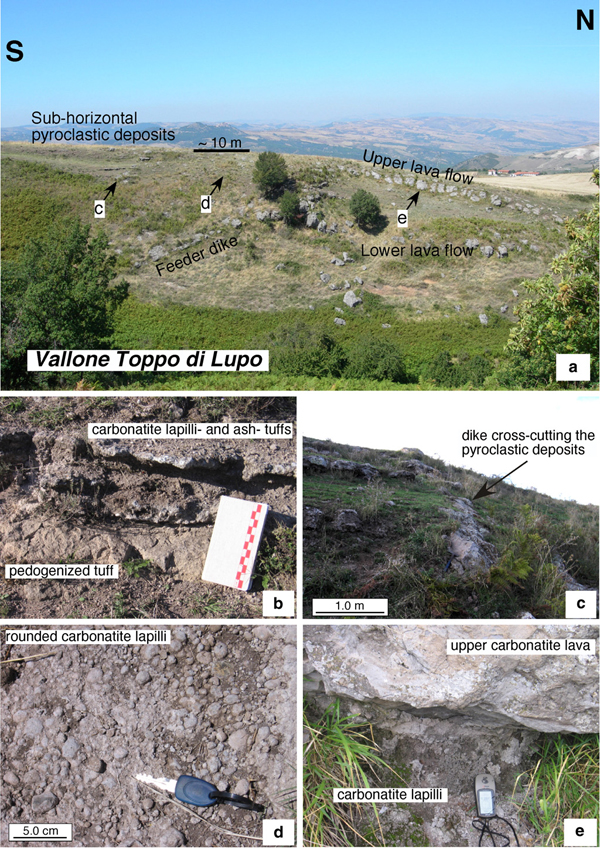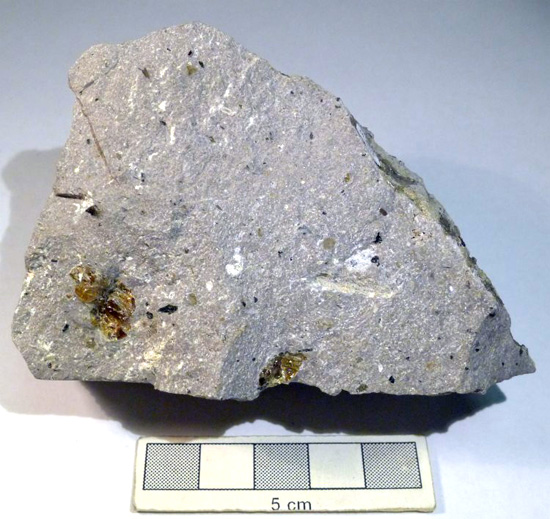Alvikite
While it is widely accepted that the parental magmas of most carbonatites ultimately derive from the mantle, the compositions of these magmas and the processes they underwent during their emplacement into the crust are still debated. Carbonatite melts may be produced directly by partial melting of carbonated mantle peridotites or may stem from CO2 rich, silica-undersaturated, silicate magmas through liquid immiscibility or crystal fractionation.Carbonatites are typically found within stable, intraplate, continental areas and along continental rifts, more rarely within or in close proximity to orogenic belts and within oceanic plates.
This variety of geological settings raised the question of the geodynamic significance of carbonatite magmatism. In turn, this is related to another major problem regarding the genesis of carbonatites, that is, how carbon is supplied to the mantle to sustain the increasing carbonatite magmatism over geological time. There is growing evidence that carbon is largely recycled back into the Earth's mantle through the subduction of crustal carbonate rocks.
Vallone toppo di lupo Alvikite
The Vallone toppo di lupo alvikite crop out in the north-western sector of Mt. Vulture, at an altitude comprised between 780 and 725 m above sea level (Fig.1). The igneous materials form a sequence of lava flows, dikes and pyroclastic deposits carved by a small, NNE-SSW-trending, valley named Vallone Toppo di Lupo (Fig.2). In this locality, the carbonatitic rocks constitute the uppermost level of the volcanic succession.
The inner structure of the Vallone toppo di lupo eruptive center is partially exposed on the western flank of the valley, whereas it is almost completely covered by colluvial detritus and vegetation on the eastern flank. The upstream side of the section is dominated by a succession of thin layers of pyroclastic rocks with a sub-horizontal or gently dipping (max 15°) layering, that mantles the pre-existing morphology.

Fig.1: (a) Sketch map of central-southern Italy with the main occurrences of the Quaternary volcanism and the front of the Apennine prism. (b) Geotectonic sketch map of the Mt. Vulture area, the arrow points to the position of the carbonatite volcanic center of Vallone Toppo di Lupo. From D'Orazio 2007.

Fig.2: Photographs of the carbonatite eruptive center of Vallone Toppo di Lupo. a) Panoramic view of the western flank of the Vallone Toppo di Lupo valley, showing the two main carbonatite lava flows (right side), the sub-horizontal carbonatite pyroclastic deposits (top left side) and the main feeder dike (center-left). Arrows point to the sites magnified in the following photographs. b) Contact between the sub-horizontal, carbonatite lapilli and ash tuffs and the light-brown pedogenized tuff (notebook scale is 22 cm). c) Small carbonatite dike cross-cutting the sub-horizontal layers of carbonatite lapilli and ash tuffs. d) Layer of ovoidal, massive, carbonatite lapilli. e) Contact between the upper carbonatite lava flow and the underlying carbonatitic lapilli.
These pyroclastics deposits have a maximum thickness of 4-5 m, overlie a sequence of matrix-supported volcanic breccia, and are separated from this latter by a 10-15 cm thick layer of light brown pedogenized tuff (Fig.2b). The pyroclastic layers are made of alternating carbonatitic lapilli and ash, variably litified by dissolution-reprecipitation of calcite.
They carry abundant xenocrysts and lithic fragments, up to decimeter-sized blocks of dark silicate lavas. Towards the central portion of the exposed section, the subhorizontal pyroclastic layers are cross-cut by a 60-70 cm thick, massive, carbonatite dike trending NW–SE (Fig.2c). To the north side of the dike is exposed a peculiar, 1-2 m thick layer made of poorly cemented, rounded carbonatite lapilli ranging in size from few millimeters up to 5-6 cm (Fig.2d).
The lapilli are subspherical to ovoidal in shape, have a smooth surface and are made of massive carbonatite. Sometimes the largest lapilli have a core of dark silicate lavas, black cumulate clinopyroxenite, or coarse grained, melilite-bearing mafic/ultramafic rocks. A larger carbonatite dike, trending N-S and dipping 40° W, is exposed in the lower central portion of the section (Fig.2a).
The two main lava flows are separated by 5 m of pyroclastic material (Fig.2e). The upper lava is 2.5 m thick and 300 m long, the lower lava is slightly thicker and apparently shorter. The Vallone toppo di lupo carbonatites have not been dated yet; however, they occur at relatively high elevations on the volcano, at the top of the local volcanic succession, and overlie a volcanic breccia deposit erupted during a late period of activity of Mt. Vulture. Moreover, they share many petrographical and volcanological features with the carbonatite-melilitite tuffs from the Monticchio Lakes. Therefore, it is likely that the Vallone toppo di lupo carbonatites have been erupted during the final phases of activity of the volcano, possibly at the same time as the maars of the Monticchio Lakes formed.
Petrography
The Vallone toppo di lupo carbonatites are made of a prevailing juvenile fraction and of subordinate amounts of extraneous material and secondary minerals. The extraneous material is represented by fragments of sedimentary rocks (limestones, clays) and silicate lavas, or by fragmented xenocrysts of diopside, melilite, amphibole and phlogopite. The sizes of these fragments range from few tens of micron to the pluridecimetric blocks found within the lapilli tuff. The juvenile fraction of the Vallone toppo di lupo carbonatites dikes and lavas shows a sub-aphyric texture with sparse (<5 vol.%) phenocrysts of calcite, melilite, apatite and Ti-magnetite set in a groundmass made of the same phases plus monticellite and Ca-Fe-Ti-Nb-LREE oxides.

Vallone toppo di Lupo alvikite. Melilite = Yellow crystals; balck = Phlogopite and pyroxene crystals.
Bibliography
• De Fino, M., La Volpe, L., Peccerillo, A., Piccarreta, G., & Poli, G. (1986). Petrogenesis of Monte Vulture volcano (Italy): inferences from mineral chemistry, major and trace element data. Contributions to Mineralogy and Petrology, 92(2), 135-145.
• D'Orazio, Massimo, et al.(2007). "Carbonatites in a subduction system: the Pleistocene alvikites from Mt. Vulture (southern Italy)." Lithos 98.1: 313-334.
• Jones, A. P., Kostoula, T., Stoppa, F., & Woolley, A. R. (2000). Petrography and mineral chemistry of mantle xenoliths in a carbonate-rich melilititic tuff from Mt. Vulture volcano, southern Italy. Mineralogical Magazine, 64(4), 593-613.
• Beccaluva, L., Coltorti, M., Di Girolamo, P., Melluso, L., Milani, L., Morra, V., & Siena, F. (2002). Petrogenesis and evolution of Mt. Vulture alkaline volcanism (Southern Italy). Mineralogy and Petrology, 74(2-4), 277-297.
• Peccerillo, A. (2005). Plio-quaternary volcanism in Italy (Vol. 365). Springer-Verlag Berlin Heidelberg.



.jpg)
.jpg)
.jpg)
.jpg)
.jpg)
.jpg)
.jpg)
.jpg)
.jpg)
.jpg)
.jpg)
.jpg)
.jpg)
.jpg)
.jpg)
.jpg)
.jpg)
.jpg)
.jpg)
.jpg)
.jpg)
.jpg)
.jpg)
.jpg)
.jpg)
.jpg)
.jpg)